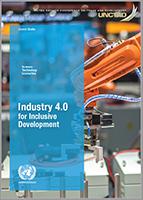
The world is at the beginning of a new technological revolution based on industry 4.0 technologies such as artificial intelligence, robotics and the Internet of things. In addition, the impact of and response to the coronavirus disease (COVID-19) pandemic have accelerated the dissemination of such digital technologies.
At its twenty-fourth session, in May 2021, the Commission on Science and Technology for Development (CSTD) selected “Industry 4.0 for inclusive development” as one of its two priority themes for the 2021–2022 intersessional period. This priority theme is relevant with regard to Sustainable Development Goal 9 on industry, innovation and infrastructure.
To contribute to a better understanding of this theme and to assist CSTD in its deliberations at its twenty-fifth session, the CSTD secretariat has prepared this study based on relevant literature and country case studies contributed by CSTD members.
The study builds in particular on the analysis and empirical evidence in two recent United Nations publications, namely Technology and Innovation Report 2021: Catching Technological Waves – Innovation with Equity , which examines how the development and diffusion of frontier technologies affect and are affected by socioeconomic inequalities; and Industrial Development Report 2020: Industrializing in the Digital Age of the United Nations Industrial Development Organization, Which focused on the emergence and diffusion of the advanced digital production technologies of industry 4.0 and their impact on the industrialization process in developing countries.
Questions addressed in this study include:
- How can developing countries take advantage of the window of opportunity presented by industry 4.0 for technological upgrading and economic catch-up?
- What can Governments do to ensure that industry 4.0 does not increase inequality?
- What is the role of international cooperation in facilitating this process?
The study is structured as follows.
Chapter II presents a big-picture view of significant trends in global inequalities, industrialization in developing countries and the effects of the pandemic on these trends. Chapter III examines the elements that constitute industry 4.0, including its longterm impact as a technological paradigm and recent market trends. Chapter IV discusses how industry 4.0 could impact inequalities through profits, wages and jobs, and the long-term effects of a technological revolution. Chapter V focuses on some of the key issues related to industry 4.0 from the perspective of developing countries. Chapter VI covers the actions Governments, the private sector and other stakeholders can take to harness industry 4.0 for inclusive development. Chapter VII discusses areas for international collaboration. Chapter VIII presents conclusions and recommendations.
Annex A highlights the experiences of some States with industry 4.0 based on contributions from CSTD members. Annex B presents questions for discussion to further the dialogue on harnessing industry 4.0 for inclusive and sustainable development.


